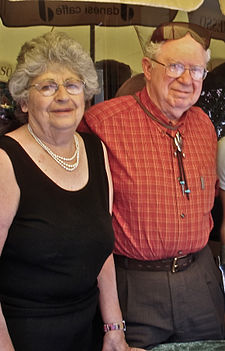Thelma Estrin | |
|---|---|
 Thelma Estrin with her husband Gerald. Santa Monica, California. Sept. 2007. | |
| Born | Thelma Austern 21 February 1924 New York City, U.S. |
| Died | 15 February 2014 (aged 89) Santa Monica, California, U.S. |
| Alma mater | University of Wisconsin–Madison (BS, MS, PhD) |
| Spouse | Gerald Estrin |
| Children | Margot Estrin Judy Estrin Deborah Estrin |
| Awards | Fulbright Scholarship (1963) IEEE Centennial Medal (1984) IEEE Haraden Pratt Award (1991) |
| Scientific career | |
| Fields | Computer science |
| Institutions | Columbia Presbyterian Hospital Los Angeles Valley College Weizmann Institute of Science UCLA |
| Thesis | Determination of the capacitance of annular-plate capacitors by the method of subareas (1951) |
| Doctoral advisor | Thomas J. Higgins[1] |
Thelma Estrin (née Austern; February 21, 1924 – February 15, 2014[2]) was an American computer scientist and engineer who did pioneering work in the fields of expert systems and biomedical engineering. Estrin was one of the first to apply computer technology to healthcare and medical research. In 1954, Estrin helped to design the Weizmann Automatic Computer, or WEIZAC, the first computer in Israel and the Middle East, a moment marked as an IEEE Milestone in Electrical and Computer Engineering.[3] She was professor emerita in the Department of Computer Science, University of California at Los Angeles (UCLA).
- ^ Nebeker, Frederik (1994). Sparks of Genius: Portraits of Electrical Engineering Excellence. New York: Institute of Electrical and Electronics Engineers. ISBN 978-0780310339.
- ^ "Thelma Estrin's Obituary by Los Angeles Times". Legacy.com. Archived from the original on 4 February 2016. Retrieved 18 July 2014.
- ^ "Milestones:List of IEEE Milestones". ETHW. 2020-12-09. Retrieved 2022-03-29.